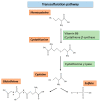Methyl Group Metabolism in Differentiation, Aging, and Cancer
- PMID: 35955511
- PMCID: PMC9369357
- DOI: 10.3390/ijms23158378
Methyl Group Metabolism in Differentiation, Aging, and Cancer
Abstract
Methyl group metabolism belongs to a relatively understudied field of research. Its importance lies in the fact that methyl group metabolic pathways are crucial for the successful conversion of dietary nutrients into the basic building blocks to carry out any cellular methylation reaction. Methyl groups play essential roles in numerous cellular functions such as DNA methylation, nucleotide- and protein biosynthesis. Especially, DNA methylation is responsible for organizing the genome into transcriptionally silent and active regions. Ultimately, it is this proper annotation that determines the quality of expression patterns required to ensure and shape the phenotypic integrity and function of a highly specialized cell type. Life is characterized by constantly changing environmental conditions, which are addressed by changes in DNA methylation. This relationship is increasingly coming into focus as it is of fundamental importance for differentiation, aging, and cancer. The stability and permanence of these metabolic processes, fueling the supplementation of methyl groups, seem to be important criteria to prevent deficiencies and erosion of the methylome. Alterations in the metabolic processes can lead to epigenetic and genetic perturbations, causative for diverse disorders, accelerated aging, and various age-related diseases. In recent decades, the intake of methyl group compounds has changed significantly due to, e.g., environmental pollution and food additives. Based on the current knowledge, this review provides a brief overview of the highly interconnected relationship between nutrition, metabolism, changes in epigenetic modifications, cancer, and aging. One goal is to provide an impetus to additionally investigate changes in DNA methylation as a possible consequence of an impaired methyl group metabolism.
Keywords: aging; cancer; cellular differentiation; methyl group metabolism.
Conflict of interest statement
The authors declare no conflict of interest.
Figures
Similar articles
-
How to Slow down the Ticking Clock: Age-Associated Epigenetic Alterations and Related Interventions to Extend Life Span.Cells. 2022 Jan 29;11(3):468. doi: 10.3390/cells11030468. Cells. 2022. PMID: 35159278 Free PMC article. Review.
-
Impacts of Chromatin States and Long-Range Genomic Segments on Aging and DNA Methylation.PLoS One. 2015 Jun 19;10(6):e0128517. doi: 10.1371/journal.pone.0128517. eCollection 2015. PLoS One. 2015. PMID: 26091484 Free PMC article.
-
Nutritional influences on epigenetics and age-related disease.Proc Nutr Soc. 2012 Feb;71(1):75-83. doi: 10.1017/S0029665111003302. Epub 2011 Nov 4. Proc Nutr Soc. 2012. PMID: 22051144 Review.
-
Dietary glycation compounds - implications for human health.Crit Rev Toxicol. 2024 Sep;54(8):485-617. doi: 10.1080/10408444.2024.2362985. Epub 2024 Aug 16. Crit Rev Toxicol. 2024. PMID: 39150724
-
The role of DNA methylation in epigenetics of aging.Pharmacol Ther. 2019 Mar;195:172-185. doi: 10.1016/j.pharmthera.2018.11.001. Epub 2018 Nov 9. Pharmacol Ther. 2019. PMID: 30419258 Free PMC article. Review.
Cited by
-
Food-sourced guanidinoacetic acid and methylation cycle biomarkers in individuals aged one year and older: a population-based cross-sectional study.Eur J Nutr. 2024 Dec;63(8):3113-3118. doi: 10.1007/s00394-024-03493-w. Epub 2024 Sep 4. Eur J Nutr. 2024. PMID: 39231873
-
Rescue of Methionine Dependence by Cobalamin in a Human Colorectal Cancer Cell Line.Nutrients. 2024 Mar 28;16(7):997. doi: 10.3390/nu16070997. Nutrients. 2024. PMID: 38613029 Free PMC article.
-
Volatile organic compounds in exhaled human breath for the diagnosis of malignant pleural mesothelioma: a meta-analysis.Front Oncol. 2025 May 28;15:1537767. doi: 10.3389/fonc.2025.1537767. eCollection 2025. Front Oncol. 2025. PMID: 40502637 Free PMC article.
-
In silico analysis of the solute carrier (SLC) family in cancer indicates a link among DNA methylation, metabolic adaptation, drug response, and immune reactivity.Front Pharmacol. 2023 Jun 15;14:1191262. doi: 10.3389/fphar.2023.1191262. eCollection 2023. Front Pharmacol. 2023. PMID: 37397501 Free PMC article.
-
Bridging epigenomics and tumor immunometabolism: molecular mechanisms and therapeutic implications.Mol Cancer. 2025 Mar 8;24(1):71. doi: 10.1186/s12943-025-02269-y. Mol Cancer. 2025. PMID: 40057791 Free PMC article. Review.
References
Publication types
MeSH terms
LinkOut - more resources
Full Text Sources
Other Literature Sources
Medical





